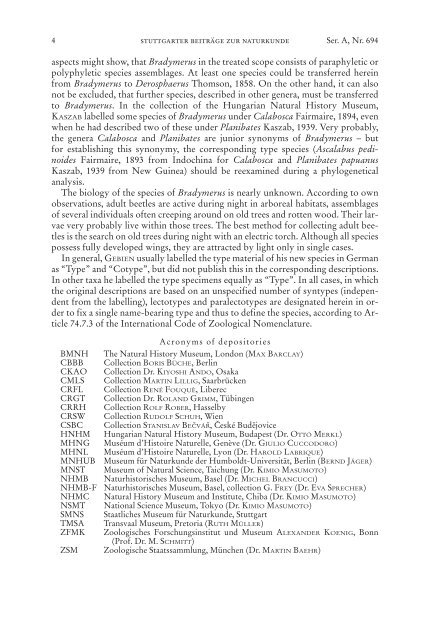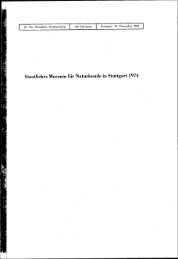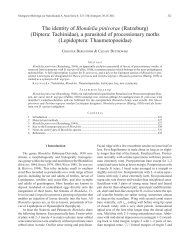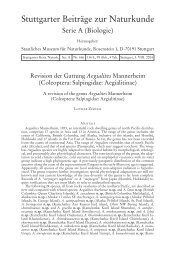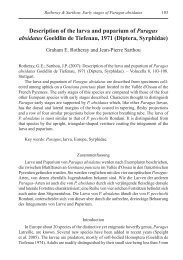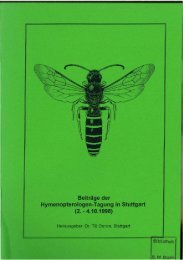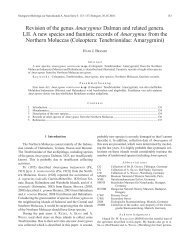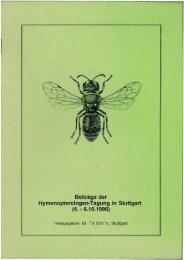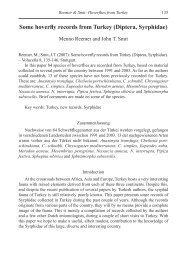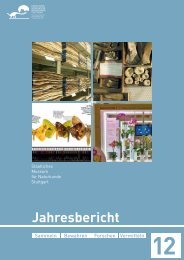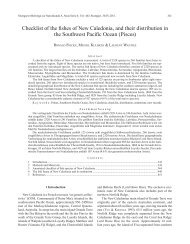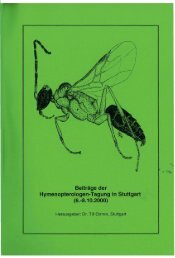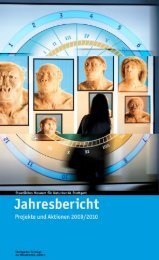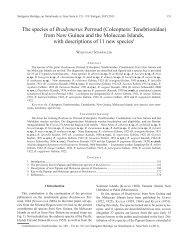Serie A (Biologie) - Staatliches Museum für Naturkunde Stuttgart
Serie A (Biologie) - Staatliches Museum für Naturkunde Stuttgart
Serie A (Biologie) - Staatliches Museum für Naturkunde Stuttgart
Create successful ePaper yourself
Turn your PDF publications into a flip-book with our unique Google optimized e-Paper software.
4 stuttgarter beiträge zur naturkunde Ser. A, Nr. 694aspects might show, that Bradymerus in the treated scope consists of paraphyletic orpolyphyletic species assemblages. At least one species could be transferred hereinfrom Bradymerus to Derosphaerus Thomson, 1858. On the other hand, it can alsonot be excluded, that further species, described in other genera, must be transferredto Bradymerus. In the collection of the Hungarian Natural History <strong>Museum</strong>,KASZAB labelled some species of Bradymerus under Calabosca Fairmaire, 1894, evenwhen he had described two of these under Planibates Kaszab, 1939. Very probably,the genera Calabosca and Planibates are junior synonyms of Bradymerus – butfor establishing this synonymy, the corresponding type species (Ascalabus pedinoidesFairmaire, 1893 from Indochina for Calabosca and Planibates papuanusKaszab, 1939 from New Guinea) should be reexamined during a phylogeneticalanalysis.The biology of the species of Bradymerus is nearly unknown. According to ownobservations, adult beetles are active during night in arboreal habitats, assemblagesof several individuals often creeping around on old trees and rotten wood. Their larvaevery probably live within those trees. The best method for collecting adult beetlesis the search on old trees during night with an electric torch. Although all speciespossess fully developed wings, they are attracted by light only in single cases.In general, GEBIEN usually labelled the type material of his new species in Germanas “Type” and “Cotype”, but did not publish this in the corresponding descriptions.In other taxa he labelled the type specimens equally as “Type”. In all cases, in whichthe original descriptions are based on an unspecified number of syntypes (independentfrom the labelling), lectotypes and paralectotypes are designated herein in orderto fix a single name-bearing type and thus to define the species, according to Article74.7.3 of the International Code of Zoological Nomenclature.BMNHCBBBCKAOCMLSCRFLCRGTCRRHCRSWCSBCHNHMMHNGMHNLMNHUBMNSTNHMBNHMB-FNHMCNSMTSMNSTMSAZFMKZSMAcronyms of depositoriesThe Natural History <strong>Museum</strong>, London (MAX BARCLAY)Collection BORIS BÜCHE, BerlinCollection Dr. KIYOSHI ANDO, OsakaCollection MARTIN LILLIG, SaarbrückenCollection RENÉ FOUQUÈ, LiberecCollection Dr. ROLAND GRIMM, TübingenCollection ROLF ROBER, HasselbyCollection RUDOLF SCHUH, WienCollection STANISLAV BEČVÁŘ, České BudějoviceHungarian Natural History <strong>Museum</strong>, Budapest (Dr. OTTÓ MERKL)Muséum d’Histoire Naturelle, Genève (Dr. GIULIO CUCCODORO)Muséum d’Histoire Naturelle, Lyon (Dr. HAROLD LABRIQUE)<strong>Museum</strong> für <strong>Naturkunde</strong> der Humboldt-Universität, Berlin (BERND JÄGER)<strong>Museum</strong> of Natural Science, Taichung (Dr. KIMIO MASUMOTO)Naturhistorisches <strong>Museum</strong>, Basel (Dr. MICHEL BRANCUCCI)Naturhistorisches <strong>Museum</strong>, Basel, collection G. FREY (Dr. EVA SPRECHER)Natural History <strong>Museum</strong> and Institute, Chiba (Dr. KIMIO MASUMOTO)National Science <strong>Museum</strong>, Tokyo (Dr. KIMIO MASUMOTO)<strong>Staatliches</strong> <strong>Museum</strong> für <strong>Naturkunde</strong>, <strong>Stuttgart</strong>Transvaal <strong>Museum</strong>, Pretoria (RUTH MÜLLER)Zoologisches Forschungsinstitut und <strong>Museum</strong> ALEXANDER KOENIG, Bonn(Prof. Dr. M. SCHMITT)Zoologische Staatssammlung, München (Dr. MARTIN BAEHR)


